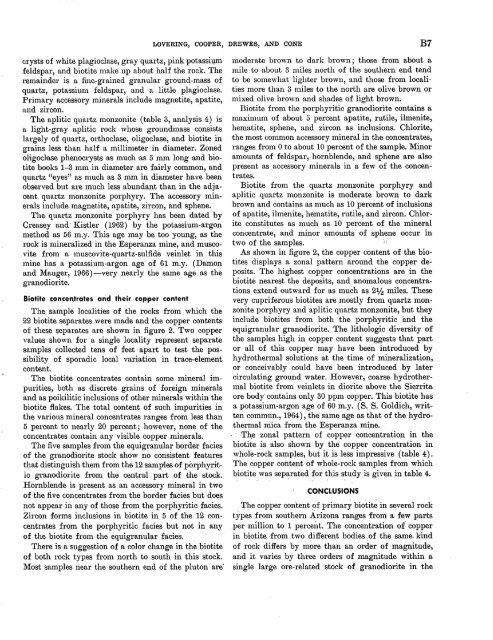RESEARCH· ·1970·
RESEARCH· ·1970·
RESEARCH· ·1970·
You also want an ePaper? Increase the reach of your titles
YUMPU automatically turns print PDFs into web optimized ePapers that Google loves.
crysts of white plagioclase, gray quartz, pink potassilPU<br />
feldspar, and biotite make up about half the rock. The<br />
remainder is a fine-grained granular ground-mass of<br />
quartz, potassium feldspar, and a little plagioclase.<br />
Primary accessory minerals include magnetite, apatite,<br />
u.nd zircon.<br />
The aplitic quartz monzonite (table 3, analysis 4) is<br />
u. light-gray nplitic rock whose groundmass consists<br />
ln.rgely of quartz, orthoclase, oligoclase, and biotite in<br />
grains less thnn half a millimeter in diameter. Zoned<br />
oligodase phenocrysts as muc;h •aJS 5 1nn1 long ·rund biotite<br />
books 1-3 mm in diameter are fairly common, and<br />
quartz "eyes" as much as 3 mm in diameter have been<br />
observed but are 1nuch less abundant than in the adjacent<br />
qunrtz monzonite porphyry. The accessory minerals<br />
include magnetite, apatite, zircon, and sphene.<br />
The quartz monzonite porphyry has been dated by<br />
Creasey and· IGstler ( 1962) by the potassium-argon<br />
method n.s 56 m.y. This age 1nay be too young, as the<br />
rock is mineralized in tJhe Esperanza mine, and muscovite<br />
from a muscovite-quartz-sulfide veinlet in this<br />
mine has n potassium-argon age of 61 m.y. (Damon<br />
and l\1auger, 1966)-very nearly the same age as the<br />
granodiorite.<br />
Bi•otite concen,trates and their cop.per conte•nt<br />
The sample localities of the rocks from which the<br />
22 biotite separates were made and the copper contents<br />
of these separates are shown in figure 2. Two copper<br />
values shown for n. single locality represent separate<br />
samples collected tens of feet apart to test the possibility<br />
of sporadic local variation in trace-element<br />
content. ·<br />
The biotite concentrates contain some mineral impurities,<br />
both as discrete grains of foreign minerals<br />
and as poikilitic inclusions of other minerals within the<br />
biotite fiakes. The total content of such impurities in<br />
the various mineral concentrates ranges from less than<br />
5 percent to nearly 20 percent; however, none of the<br />
concentrates contain any ·visible copper minerals.<br />
The five samples from the equigranular border facies<br />
of the granodiorite stock show no consistent features<br />
that di,stinguish them from the 12 samples of porphyritic<br />
granodiorite from the central part of the stock.<br />
I-Iornblende is present as an accessory .mineral in two<br />
of.the five concentrates frmn the border facies· but does<br />
~10t appear in any of those from the porphyritic facies.<br />
Zircon forms inclusions in biotite in 5 of the 12 concentrates<br />
from the porphyritic facies but not in any<br />
of the biotite from the· equigranular facies.<br />
There is a suggestion of a color change in the biotite<br />
of both rock types from north to south in this stock.<br />
Most samples near the southern end of the pluton are'<br />
LOVERING, COOPER, DREWES, AND CONE<br />
B7<br />
1noderate brown to dark brown; those from about a<br />
mile to n.bout 3 miles north of the southern end tend<br />
to be so mew hat lighter brown, and those from localities<br />
more than 3 1niles to the north are olive brown or<br />
1nixed olive brown and shades of light brown.<br />
Biotite from the porphyritic granodiorite contains a<br />
maxin1um of about 5 percent apatite, rutile, ihnenite,<br />
hematite, sphene, and zircon as inclusions. Chlorite,<br />
the most common accessory mineral in the concentrates,<br />
ranges from 0 to about 10 percent of the sample. Minor<br />
amounts of feldspar, hornblende, and sphene are also<br />
present as accessory minerals in a few of the concentrates.<br />
Biotite from the quartz monzonite porphyry and<br />
aplitic quartz monzonite is moderate brown to dark<br />
brown and contains as much as 10 percent of inclusions<br />
of apatite, ilmenite, hematite, rutile, and zircon: Chlorite<br />
constitutes as much as 10 percent of the mineral<br />
concentrate, and minor amounts· of sphene occur in<br />
two of the sam pies. ·<br />
As shown in figure 2, the copper content of the biotites<br />
displays a zonal patterri around the copper deposits.<br />
The highest ·copper concentrations are· in the<br />
biotite nearest the deposits, and anomalous concentrations<br />
extend outward for as much a~ 2112 miles. These<br />
very cupriferous biotites are mostly from quartz monzonite<br />
porphyry and aplitic quartz monzonite, but they<br />
include biotites from both the porphyritic itnd the<br />
equigranular granodiorite. The lithologic diversity of<br />
the samples high in copper content suggests that part<br />
or all of this copper may have been introduced by<br />
hydrothermal solutions at the time of mineralization,<br />
or conceivably could have been introduced by later<br />
circulating ground water. However, coarse hydrothermal<br />
biotite from veinlets in diorite above the Sierrita<br />
ore body' contains only 30 ppm copper. This biotite has<br />
a potassium-argon age of 60 m.y. (S. S. Goldich, written<br />
commun., 1964), the same age as that of the hydrothermal<br />
mica from the ·Esperanza mine.<br />
. · ·Th,e zonal pattern of copper concentration in the<br />
biotite is also shown· by the copper concentration in<br />
whole-rock samples, but it is less impressive (table 4).<br />
The copper content of whole-rock samples from which<br />
biotite was sep~rated for ~his s~udy is given in table 4.<br />
CONCL·US1IONS<br />
The copper content 9f primary bi~tit~ in several rock<br />
types from southe~n Arizona ranges from a f~w parts<br />
.per m!llion t~ 1 percei1t. The concentration of copper<br />
in biotite ·from two differen.t bodies of the same. kind<br />
of rock differs by more than an order of magnitude,<br />
and it varies by three orders of magnitude within a<br />
single large ore-related stock of granodiorite in the
















